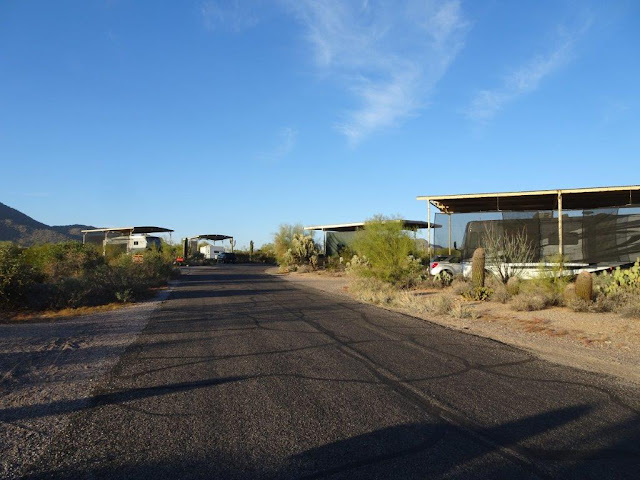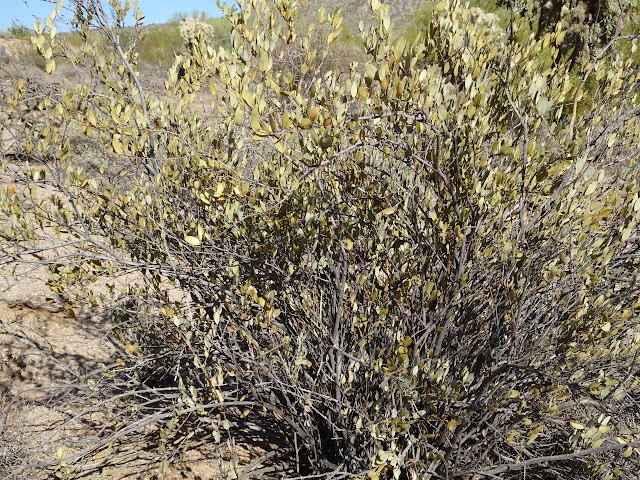I think of all the poor travelers who have to stay in hotels that are missing all of this outside of their windows. And tonight, just at dusk, a coyote walked through my campsite on his way to a night of hunting. I will no doubt hear them howling later in the evening. Great sound!
The mountain here is called Slash Mountain. Usery Mountain is to the west on the other side of the entrance sign. Slash Mountain is easily recognizable from a long distance by its "slash."
As you can see, the slash in Slash Mountain is just a cliff face with contrasting rock showing.
Almost every campground has camp hosts, who are usually volunteers who in return for a free campsite for several months, check in campers and make sure the campground is in good condition and campers are behaving themselves. Frankly, since this time of year the campers are almost entirely old folks like me, it is a pretty quiet place so not too much work to supervise. Many camp hosts are retired people like me who live RVs full-time, but who use this trade-off a few months a year to reduce their travel budgets and enjoy getting to know one area well. (In spite of some magazine articles, they are NOT poverty-stricken old folks who have no place to live. Many have much more expensive rigs than I do.)
Because it is so hot here much of the year, the camp hosts have huge roofs over their RVs, and there are also black mesh nets on some of the sides to block the sun.
I am relearning the names of shrubs and cactus, so I will try to identify the ones I took photos of around my campsite and on a ranger walk I participated in. This is a creosote bush. It has little yellow flowers and if you rub the tiny leaves between your fingers or pour some water on some leaves, you will discover it smells like an electric fire or burning rubber.
This cholla has a lot of hanging buds. I was told it produces one bud at the end of the string of hanging buds each year. And, they are edible by humans and a wide variety of animals. However, why are these still hanging after apparently several years of production? The answer is that they taste horrible, and most animals will eat them only if absolutely nothing else is available. And humans have to go through a lengthy process of removing the tiny thorns and cooking them. They also cause extremely gastrointestinal problems if too many are eaten, so beware.
Looked this one up, and it is buckhorn cholla. Cholla, by the way, are sometimes called "jumping cholla" because segments of the branches are likely to catch on your clothing and skin with the lightest of touch. The segments also lie in wait on the desert floor, hoping someone will pick them up as they walk by. DO NOT TRY TO PULL THESE OFF WITH YOUR BARE HANDS! Most people will carry combs or needle nose pliers when they go for a walk. Another warning is to keep your dogs on main paths or roadways if you take them for a walk, as they also get cholla spines in them very easily.
 |
Prickly pear. You can buy farm-grown fruits and pads of this cactus in some grocery stores.
This is paloverde. It can be easily identified because the bark on the trunks and branches is also green. Basically, what the plant is doing is keeping leaves very small so they do not lose water and gaining extra chlorophyll on its branches.
And this is a jojoba plant. It produces the oil found in a lot of cosmetics.
And, of course, this is a hedgehog cactus. The individual shoots are only about 6' tall.
This is another type of hedgehog cactus, but cuter, and smaller! These plants were only about 4" tall. Notice that it has two levels of spines--long outside spines and inside spines.
Behind the visitor center, they have set up a small pond and several bird feeders.
A hummingbird. These are extremely common in this area, but it is hard to get good photos of them,
This young saguaro was about three feet tall and about 30-40 years old.
This baby was only about 2' tall, so maybe 25 years old.
This one was about 4' tall. I am getting good at finding them now.
This one was about 8' tall, so maybe 60 years old.
This 15' footer is at least 75-100 years old. It is ready to grow arms and will produce flowers and fruit at this age.
This beauty is at least 150 years old and might be 200 years old. It might weigh two tons and produces gorgeous white flowers at its top and on each of its arms that become red fruit filled with black seeds. The juicy fruit is scraped and boiled to produce a sweet syrup and seeds that are stored and pounded into other foods, such as bread.
It has not rained recently, but the last time it did rain hard last fall, the volunteer said this wash was full of raging water.
Overall, a beautiful and peaceful place. I am headed to Tucson area on Monday, but I will be back here in mid-March and expect to see a lot of the desert in bloom.
























No comments:
Post a Comment